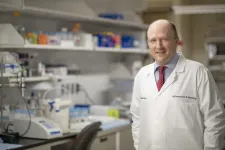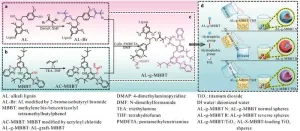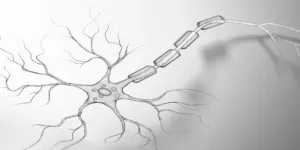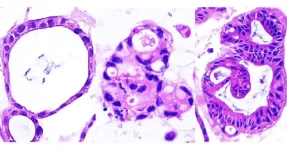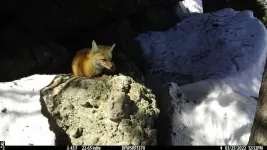(Press-News.org) Inspired by an ancient buried log, researchers present a novel method to remove and store atmospheric carbon for hundreds of years or more. It involves locking woody biomass away in “wood vaults.” The approach could provide a cost-effective solution to mitigate climate change. Achieving net-zero carbon dioxide (CO2) emissions is crucial for combating climate change, yet reducing fossil fuel emissions alone is insufficient to meet the Paris Agreement's targets. To achieve these goals, carbon dioxide removal (CDR) methods must be implemented, including engineering solutions, like direct air capture, and nature-based approaches, such as reforestation or afforestation. Forests play a crucial role in the climate change discourse as significant carbon sinks in natural carbon cycles, sequestering atmospheric carbon through photosynthesis. However, the carbon stored in wood via this natural carbon cycle is often quickly returned to the atmosphere due to decomposition or burning of biomass, leaving little net impact on atmospheric carbon. It is unknown whether carbon-storing woody biomass can be preserved long enough (hundreds of years or longer) to have an appreciable effect on reducing anthropogenic CO2 in the atmosphere. Here, Ning Zeng and colleagues explore the viability of a CDR strategy involving burying sustainably sourced wood in an engineered structure called a “wood vault” to prolong the duration of carbon storage by preventing decay and decomposition. This novel method was inspired by the discovery of a remarkably preserved 3775-year-old Eastern red cedar log buried in clay soil in Quebec, Canada – a find that demonstrates the potential for long-term carbon storage through wood burial within certain environments. By comparing the ancient log to a modern sample from the same species, Zeng et al. found that, despite being buried for nearly 4 millennia, the ancient wood had only lost up to 5% of its carbon, likely due to the low permeability and anoxic nature of the compact clay soil in which it was buried. Using carbon cycle modeling and forestry data, the authors estimate that up to 10 gigatons of CO2 could be sequestered via wood vaulting annually, using trees as well as underutilized wood residues, such as urban tree waste and forest byproducts from commercial thinning. The authors also estimated an initial CDR cost of only $100 to $200 per ton. “A full life-cycle assessment is needed to quantify the net emissions and environmental impacts across ecosystems, supply chains, and engineered wood vaults, as well as to understand how these impacts vary by location and wood sources,” writes Yuan Yao in a related Perspective. “These understandings will be critical to developing biomass burial projects on a global scale.”
A segment of Science's weekly podcast with Ning Zeng, related to this research, will be available on the Science.org podcast landing page after the embargo lifts. Reporters are free to make use of the segments for broadcast purposes and/or quote from them – with appropriate attribution (i.e., cite "Science podcast"). Please note that the file itself should not be posted to any other Web site.
END
Ancient, buried wood inspires a possible low-cost method to store carbon
Summary author: Walter Beckwith
2024-09-26
ELSE PRESS RELEASES FROM THIS DATE:
Removal of marine plastic fishery debris greatly reduces entanglement threat for endangered Hawaiian monk seals
2024-09-26
Large-scale removal of discarded fishing gear and other plastic debris from the waters of Northwestern Hawaii meaningfully reduced entanglement rates of endangered Hawaiian monk seals, according to a new study. The findings, which are drawn from more than four decades of data, offer promising evidence that marine debris cleanup programs are successful and that reducing plastic inputs and scaling up removal efforts could maximize conservation outcomes across marine ecosystems worldwide. Plastic pollution severely threatens marine ecosystems, ...
Climate change likely to increase diarrheal disease hospitalizations by 2100s
2024-09-26
By 2100, hospitalizations from diarrheal diseases are predicted to increase in the city of Dhaka in Bangladesh as a result of climate change, even if global warming stays under 2 degrees Celsius. Farhana Haque and colleagues from University College London, London School of Hygiene and Tropical Medicine and icddr,b report these findings in a new study published September 26 in the open access journal PLOS Neglected Tropical Diseases.
As one of the world’s most densely population cities, Dhaka deals with a high burden of diarrheal diseases. While some studies have looked at how weather affects diarrhea in Bangladesh, few have examined the future impact of climate ...
Cleveland Clinic researchers discover new bacterium that causes gut immunodeficiency
2024-09-26
September 26, 2024, Cleveland: Cleveland Clinic researchers have discovered a new bacterium that weakens the immune system in the gut, potentially contributing to certain inflammatory and infectious gut diseases.
The team identified the bacterium, Tomasiella immunophila (T. immunophila), which plays a key role in breaking down a crucial immune component of the gut’s multi-faceted protective immune barrier.
Identifying this bacterium is the first step to developing new treatments for a variety of inflammatory and infectious gut diseases. These conditions, including inflammatory ...
Research reveals impact of gut microbiome on hormone levels in mice
2024-09-26
Francis Crick Institute press release
Under strict embargo: 19:00hrs Thursday 26 September 2024
Peer reviewed
Experimental study
Animals
Researchers at the Francis Crick Institute have shown that the balance of bacteria in the gut can influence symptoms of hypopituitarism in mice.
They also showed that aspirin was able to improve hormone deficiency symptoms in mice with this condition.
People with mutations in a gene called Sox3 develop hypopituitarism, where the pituitary gland doesn’t ...
Lignin-based sunscreen offers natural and high-performance UV protection
2024-09-26
In a significant breakthrough for the cosmetics industry, researchers have developed a new type of sunscreen using lignin, a naturally abundant polymer, and titanium dioxide (TiO2). The study, led by Yarong Li and Zhiguang Tang, was published in the Journal of Bioresources and Bioproducts and details the innovative use of a dual-modified lignin sub-microsphere to enhance the SPF and improve the color of sunscreens.
Lignin, a byproduct of the pulp industry, is known for its UV-absorbing properties and antioxidant capabilities. However, its application in commercial sunscreens has been limited due ...
How are stretch reflexes modulated during voluntary movement?
2024-09-26
How did the bodies of animals, including ours, become such fine-tuned movement machines? How vertebrates coordinate the eternal tug-o-war between involuntary reflexes and seamless voluntary movements is a mystery that Francisco Valero-Cuevas’ Lab in USC Alfred E. Mann Department of Biomedical Engineering, set out to understand. The Lab’s newest computational paper published in the Proceedings of the National Academy of Sciences (PNAS) adds to the thought leadership about the processing of sensory information and control of reflexes during voluntary movements—with implications as to how its disruption could ...
Organoids derived from gut stem cells reveal two distinct molecular subtypes of crohn’s disease
2024-09-26
Crohn’s disease — an autoimmune disorder — is characterized by chronic inflammation of the digestive tract, resulting in a slew of debilitating gastrointestinal symptoms that vary from patient to patient. Complications of the disease can destroy the gut lining, requiring repeated surgeries. The poorly understood condition, which currently has no cure and few treatment options, often strikes young people, causing significant ill-health throughout their lifetime. One barrier to making progress in developing treatments has been the lack of preclinical animal models that accurately ...
Rates of sudden unexpected infant death changed during the COVID-19 pandemic
2024-09-26
HERSHEY, Pa. — The risk of sudden unexpected infant death (SUID) and sudden infant death syndrome (SIDS) increased during the COVID-19 pandemic compared to the pre-pandemic period, especially in 2021, according to a new study led by researchers at the Penn State College of Medicine. Monthly increases in SUID in 2021 coincided with a resurgence of seasonal respiratory viruses, particularly respiratory syncytial virus (RSV), suggesting that the shift in SUID rates may be associated with altered infectious disease transmission.
They ...
Genetic rescue for rare red foxes?
2024-09-26
A rescue effort can take many forms – a life raft, a firehose, an airlift. For animals whose populations are in decline from inbreeding, genetics itself can be a lifesaver.
Genomic research led by the University of California, Davis, reveals clues about montane red foxes’ distant past that may prove critical to their future survival. The study, published in the journal Molecular Biology and Evolution, examines the potential for genetic rescue to help restore populations of these mountain-dwelling red foxes. The research is especially relevant for the estimated ...
Extreme heat impacts daily routines and travel patterns, study finds
2024-09-26
A groundbreaking new study conducted by a team of researchers from Arizona State University, University of Washington and the University of Texas at Austin reveals that extreme heat significantly alters how people go about their daily lives, influencing everything from time spent at home to transportation choices. The study, titled "Understanding How Extreme Heat Impacts Human Activity-Mobility and Time Use Patterns," was recently published in Transportation Research Part D and underscores the urgent need for policy action ...
LAST 30 PRESS RELEASES:
Tracing the quick synthesis of an industrially important catalyst
New software sheds light on cancer’s hidden genetic networks
UT Health San Antonio awarded $3 million in CPRIT grants to bolster cancer research and prevention efforts in South Texas
Third symposium spotlights global challenge of new contaminants in China’s fight against pollution
From straw to soil harmony: International team reveals how biochar supercharges carbon-smart farming
Myeloma: How AI is redrawing the map of cancer care
Manhattan E. Charurat, Ph.D., MHS invested as the Homer and Martha Gudelsky Distinguished Professor in Medicine at the University of Maryland School of Medicine
Insilico Medicine’s Pharma.AI Q4 Winter Launch Recap: Revolutionizing drug discovery with cutting-edge AI innovations, accelerating the path to pharmaceutical superintelligence
Nanoplastics have diet-dependent impacts on digestive system health
Brain neuron death occurs throughout life and increases with age, a natural human protein drug may halt neuron death in Alzheimer’s disease
SPIE and CLP announce the recipients of the 2025 Advanced Photonics Young Innovator Award
Lessons from the Caldor Fire’s Christmas Valley ‘Miracle’
Ant societies rose by trading individual protection for collective power
Research reveals how ancient viral DNA shapes early embryonic development
A molecular gatekeeper that controls protein synthesis
New ‘cloaking device’ concept to shield sensitive tech from magnetic fields
Researchers show impact of mountain building and climate change on alpine biodiversity
Study models the transition from Neanderthals to modern humans in Europe
University of Phoenix College of Doctoral Studies releases white paper on AI-driven skilling to reduce burnout and restore worker autonomy
AIs fail at the game of visual “telephone”
The levers for a sustainable food system
Potential changes in US homelessness by ending federal support for housing first programs
Vulnerability of large language models to prompt injection when providing medical advice
Researchers develop new system for high-energy-density, long-life, multi-electron transfer bromine-based flow batteries
Ending federal support for housing first programs could increase U.S. homelessness by 5% in one year, new JAMA study finds
New research uncovers molecular ‘safety switch’ shielding cancers from immune attack
Bacteria resisting viral infection can still sink carbon to ocean floor
Younger biological age may increase depression risk in older women during COVID-19
Bharat Innovates 2026 National Basecamp Showcases India’s Most Promising Deep-Tech Ventures
Here’s what determines whether your income level rises or falls
[Press-News.org] Ancient, buried wood inspires a possible low-cost method to store carbonSummary author: Walter Beckwith
